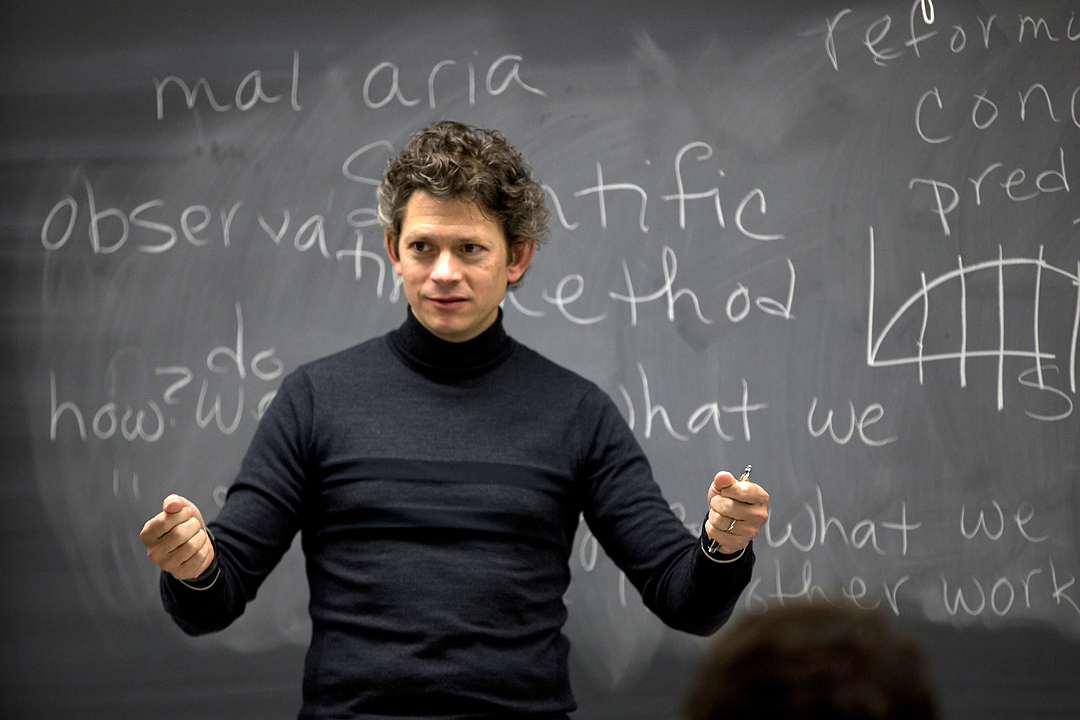
Each week this fall, we’ll introduce new Bates professors who have tenure-track positions on the faculty.
This year’s nine tenure appointments are in the disciplines of art and visual culture, classical and medieval studies, economics, English, environmental studies, dance, politics (two appointments), and psychology.
This week we introduce the fourth of our nine new faculty members, Tyler Harper.
Name: Tyler Harper
Position: Assistant Professor of Environmental Studies
Degrees from: New York University, Ph.D. in comparative literature and M.A. in comparative literature; Haverford College, B.A. in English

His work: Harper researches the evolving ways in which science fiction writers have depicted human extinction, and how the concept of extinction has changed since 1796, when scientist Georges Cuvier proved that species extinction was in fact possible.
Completed in May, Harper’s dissertation was on “The Specter of Extinction: Environmental Nihilism in British Science Fiction (1800–1945).
Why sci-fi? With a literary canon that includes books from L. Ron Hubbard, and with movie titles like Abbott and Costello Meet the Invisible Man, science fiction in America is a “heavily stereotyped genre,” Harper says. “We’re often used to thinking of sci-fi as entertainment or as beach reading.” Plus, it’s a genre that’s frequently “coded as both white and male,” he says.
For a liberal arts professor, stereotype is a door waiting to be kicked open. “One of the joys of teaching science fiction is getting students to see sci-fi differently — as a genre that not only engages with big ideas but also that includes some great works written by marginalized voices.”
A sample lesson: Harper says that he’s always loved introducing students to the novel Dawn, by Octavia Butler, the first Black female science fiction writer to reach national prominence.
One of her earlier works, Dawn poses the “big questions that I find tend to excite students. Questions like, is the fear of otherness innate? Or is it learned? Can it be unlearned? And, is the exploitation of nature or other species ever justifiable?”
In class, he’ll lead an exercise in argument mapping to “break down the various worldviews presented by a novel or film and look who is presenting those views, how they clash, and how they’re reconciled.”
The exercise “gets students to slow down, look past the aliens and the spaceships, and really confront the profound and topical questions about the environment and our place in it that a novel like Dawn conveys.”
Why Bates? “Bates struck me as an institution that really strives to navigate a balance,” Harper says. While “upholding the traditional concept of a liberal arts college as a space in which students are able to think on a campus — free from the distractions of the world around them,” the college also works to bring “the liberal arts model into the 21st century.”

Imagining Extinction: British science fiction writers of the 1800s and early 1900s, like Mary Shelley, Edward Bulwer-Lytton, and H.G. Wells, imagined that the natural world was the prime threat to human life.
In their works, “nature was re-imagined as not only a threat to the species, but a threat to the very moral vision that informed Western thinking about humanity in general,” Harper says. He calls this ‘environmental nihilism’: the threat of meaninglessness posed by the recognition that nature is completely indifferent to human existence.”
In Britain during the early Romantic era — the late 1700s into the early 1800s — these initial extinction narratives also tended to “imagine threats to the species as arising from absolute catastrophes that could not be avoided or prevented,” he explains.
Later, particularly in the wake of Darwin’s discoveries in the mid-1800s, the threat of extinction was re-imagined as “something that could be mitigated by human ingenuity and power, something we might be able to prepare for politically, technologically, scientifically and so on. This view still informs contemporary reflection on human extinction.”
The idea that nature was the major threat to humankind changed after the U.S. dropped atomic bombs on Japan: “Human extinction was now recognized as something that humans might bring about,” says Harper.
Now, climate change: A legacy of 19th- and early 20th-century science fiction is today’s belief that “we can confront the threat of climate change with large-scale technological solutions, like geo-engineering,” Harper says.
However, clinging to a magic-bullet solution, he says, merely “becomes a way to avoid thinking about climate change as a political crisis.” Today’s science fiction can address this avoidance and reinforce the politics of the climate crisis by imagining the “ways different groups of people are more or less implicated by environmental violence.”
In other words, writers of climate fiction can show us new worlds after climate change and raise the question: Who gets to live in these new worlds?
Any catastrophe, whether it threatens extinction or not, “impacts different racial groups unequally and acts on different communities in different nations unequally. It’s imperative that we think about a problem that seems fantastical but is in fact quite pressing.”
Do we survive? “I remain an optimist,” Harper says. “But I think one of the reasons I’m drawn to thinking about human extinction is that there are people with tremendous power and wealth who take the question of human extinction very seriously. You have people in Silicon Valley building compounds in New Zealand in preparation for a coming climate catastrophe.”
Harper adds, “We have, especially in academia, a duty to think seriously about this as well and to draw attention to the oversimplifications that we see in a news item, for example, about Elon Musk wanting to establish a human colony on Mars as a backup if Earth were to become uninhabitable.”




